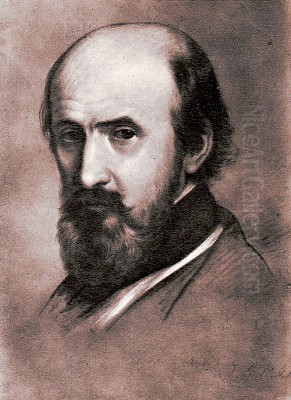
Károly Markó the Elder, also known internationally as Carlo Marco, stands as a seminal figure in the history of Hungarian art. Born in 1791 and passing away in 1860, he is widely celebrated as one of the most important Hungarian landscape painters of the 19th century. His work marks a transition from Neoclassicism towards Romanticism, and he played a crucial role in establishing landscape painting as a significant genre within his homeland. Though he spent a considerable part of his successful career in Italy, his influence on Hungarian art remained profound, and he was recognized with membership in the Hungarian Academy of Sciences.
Early Life and Artistic Inclinations
Károly Markó was born in Lőcse, Upper Hungary, which is now Levoča in Slovakia, in 1791. His initial path was not directed towards the arts. Reflecting the practical demands and opportunities of the time, he first pursued studies in engineering. He undertook apprenticeships in Pest and Kolozsvár (now Cluj-Napoca, Romania), acquiring technical skills that would lead him to professional work.
Between 1812 and 1818, Markó applied his engineering knowledge, working in towns like Ólubló (now Stará Ľubovňa, Slovakia) and Rozsnyó (now Rožňava, Slovakia). It was during this period, however, that his latent passion for art began to surface more strongly. Around 1818, while still based in Ólubló, he created his first known paintings. These early efforts often involved copying or imitating the works of established contemporary artists, a common practice for aspiring painters seeking to understand technique and composition.
The Path to Professional Artistry
Recognizing that his true calling lay in painting, Markó made a decisive move in 1818. He relocated to Pest (part of modern-day Budapest) with the specific aim of honing his artistic abilities. This marked a formal commitment to pursuing art as a profession. He immersed himself in the artistic environment of the city, likely seeking out instruction and opportunities to study the works of others.
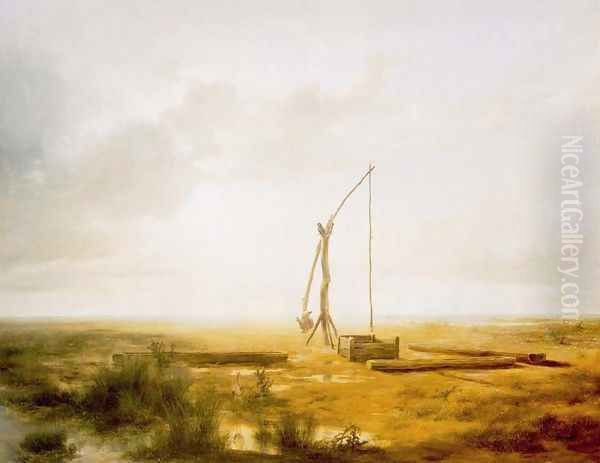
His dedication began to bear fruit, and by the early 1820s, Markó started exhibiting his paintings in Pest. This exposure was crucial for gaining recognition and establishing himself within the local art scene. However, seeking more rigorous and formal training, he made another significant move in 1822, traveling to Vienna, the imperial capital and a major European cultural hub.
Academic Training in Vienna and Rome
In Vienna, Markó enrolled at the prestigious Imperial Academy of Fine Arts (Akademie der bildenden Künste Wien). He studied there from 1822 until 1826, focusing primarily on history painting and landscape painting. The Academy provided a structured environment where he could refine his draughtsmanship, learn academic compositional principles, and study the works of Old Masters. His time in Vienna exposed him to the prevailing artistic currents, including the lingering influence of Neoclassicism and the burgeoning Romantic movement. Figures like the Austrian Biedermeier painters Ferdinand Georg Waldmüller and Friedrich von Amerling were active during or shortly after this period, contributing to the rich artistic milieu of the city.
After his studies in Vienna, Markó's ambition led him further south. By 1832, he had arrived in Rome, the ultimate destination for many artists seeking inspiration from classical antiquity and the Italian landscape. In Rome, he sought out the mentorship of Joseph Anton Koch, a prominent Austro-German painter associated with the Neoclassical landscape tradition but also a key figure for the Nazarene movement. Koch's influence, particularly his structured, idealized landscapes often imbued with historical or mythological significance, likely resonated with Markó. The Nazarenes, including artists like Friedrich Overbeck and Peter von Cornelius, aimed to revive German art through principles drawn from the Early Italian Renaissance and religious sincerity, and Koch's circle provided a connection to these ideals.
Artistic Style: Idealized Romanticism
Károly Markó the Elder developed a distinctive style characterized by idealized Romantic landscapes. While rooted in the classical landscape tradition exemplified by 17th-century masters like Claude Lorrain and Nicolas Poussin, Markó infused his scenes with a softer, more lyrical Romantic sensibility. His landscapes are meticulously composed, often featuring serene settings, balanced arrangements of trees, water, and classical ruins or pastoral figures.
His approach differed from the more dramatic or sublime aspects of Romanticism found in the work of some contemporaries. Instead, Markó favoured harmony, clarity, and a gentle, often idyllic mood. His paintings frequently depict the warm, golden light of the Italian countryside, rendered with remarkable sensitivity. There is a palpable sense of peace and timelessness in his best works.
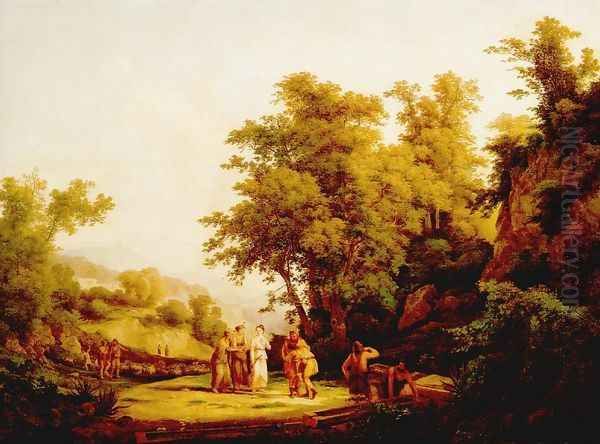
Influences from Italian art are evident. The provided text mentions the impact of the Baroque painter Annibale Carracci, likely referring to the structured, idealized approach to landscape seen in Carracci's work, which was foundational for later artists like Lorrain and Poussin. Markó's refined technique and delicate handling of paint also align with the characteristics noted as prevalent in Italian Romantic painting of the era. Furthermore, his sophisticated use of colour, particularly the atmospheric effects and light, has been linked to an appreciation for the Venetian Old Masters, known for their mastery of colour and light.
Major Themes and Representative Works
Markó's oeuvre primarily consists of landscapes, but these often incorporate mythological, biblical, or historical themes, reflecting his academic training. He painted both the landscapes of his native Hungary and, more frequently after his move, the Italian Campagna and other scenic locations in Italy.
Several key works exemplify his style and thematic interests:
The Great Hungarian Plain with Draw Well (1853): This painting showcases his ability to capture the specific character of the Hungarian landscape, albeit through his typically idealized lens. The vastness of the Puszta is rendered with atmospheric perspective.
Landscape at Appeggi (1853): Likely depicting the area around Appeggi, near Florence, where he later settled, this work would exemplify his mature Italian landscape style, characterized by serene beauty and warm light.
Meeting of Jacob and Laban (1832): This biblical scene demonstrates his skill in history painting, integrating figures into an expansive, carefully constructed landscape setting. The narrative element is presented within an idealized natural world.
Baptism of Christ in the Jordan (1838): Another significant religious work, likely combining Markó's landscape skills with the depiction of a key New Testament event, treated with solemnity and classical balance.
Italian Landscape in Evening Sunlight: Housed in the Liechtenstein Palace in Vienna, this title perfectly encapsulates a common theme and mood in his work – the picturesque Italian scenery bathed in the evocative light of dusk.
Aqua Nera near Rome (1858): Depicting a specific location near Rome, this work likely highlights his continued engagement with the Italian landscape late in his career.
Diana Hunting (dated 1820 in source): An earlier work possibly exploring mythological themes, showcasing the integration of classical figures within a natural setting, a common academic practice.
These works consistently demonstrate Markó's meticulous technique, his love for balanced compositions, and his ability to evoke a sense of timeless beauty and tranquillity.
Career Success in Italy and Recognition
Markó spent a significant portion of his productive life in Italy, primarily in Rome and later near Florence. He achieved considerable success and recognition both within Italy and internationally. His idealized landscapes found favour with collectors and patrons across Europe.
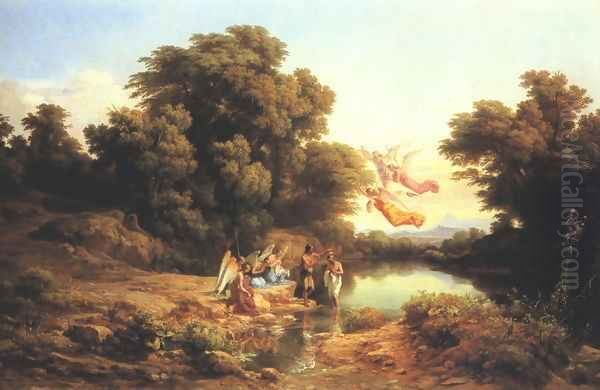
His connection to Hungary remained strong despite living abroad. He received significant patronage from Hungarian aristocrats, such as Count István Károlyi, who commissioned works from him, including paintings for the church in Fót, Hungary. This patronage was vital for his financial stability and indicates the high regard in which he was held by his countrymen.
A major honour came when he was elected a member of the Hungarian Academy of Sciences in recognition of his artistic achievements. This solidified his status as a leading cultural figure in Hungary. His works entered important public collections, including the Hungarian National Museum in Budapest and prestigious international collections like that of the Princes of Liechtenstein in Vienna. He exhibited his works not only in Pest and Vienna but likely also in Italian art centres, contributing to his European reputation.
Contemporaries and Artistic Network
While Markó developed a distinct personal style, he operated within a broader European artistic context. His teacher, Joseph Anton Koch, was a crucial link to both Neoclassical landscape ideals and the Nazarene circle (Overbeck, Cornelius). His style shows an awareness of the classical landscape tradition (Lorrain, Poussin, Carracci).
In Hungary, his contemporary Miklós Barabás was a leading figure primarily in portraiture and genre scenes, representing a different facet of Hungarian Biedermeier and Romantic art. Markó's dedication to landscape set him apart and established a benchmark for future generations. Later Hungarian landscape painters would build upon the foundations he laid, though figures like Mihály Munkácsy (active later) would move towards Realism.
During his time in Vienna, the art scene included prominent figures like Waldmüller and Amerling. In Italy, he would have been aware of contemporary Italian landscape painters, perhaps figures associated with the Posillipo School in Naples like Giacinto Gigante, or painters working in Rome and Florence, such as the veduta painter Giovanni Migliara, although Markó's style remained more idealized and less focused on topographical accuracy than typical vedute. His connection to the Hungarian Academy placed him within the network of leading Hungarian intellectuals and artists of his time.
Legacy and Enduring Influence
Károly Markó the Elder's legacy is multifaceted. He is considered the founder of modern Hungarian landscape painting, elevating the genre and setting a high standard of technical skill and artistic vision. His idealized, Romantic style provided a model that influenced subsequent generations of Hungarian artists, even as later movements like Realism and Impressionism emerged.
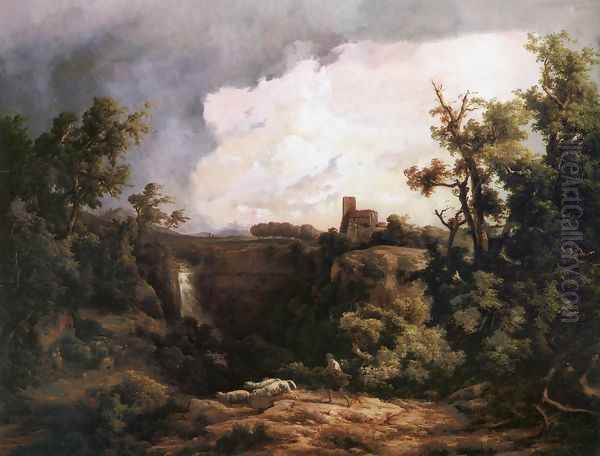
His decision to live and work extensively in Italy allowed him to absorb classical and Renaissance influences directly, enriching his art and bringing a sophisticated, European sensibility to his depictions of both Italian and Hungarian scenery. He successfully bridged the gap between the structured ideals of Neoclassicism and the emotive qualities of Romanticism.
His international success demonstrated that Hungarian artists could compete on the European stage. Furthermore, his artistic lineage continued through his sons, most notably Károly Markó the Younger, who also became a respected landscape painter, largely following in his father's stylistic footsteps.
Károly Markó the Elder passed away in 1860 at Villa Appeggi, near Florence, Italy, the country that had become his second home and a profound source of inspiration. His works remain highly esteemed and are prominently displayed in major Hungarian museums and international collections, securing his place as a pivotal figure in 19th-century European art and a cornerstone of Hungarian national painting.